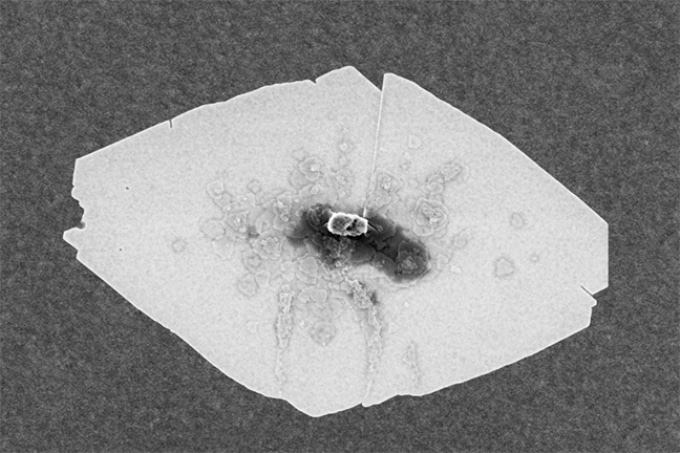Mar 16 2017
 This scanning electron microscope (SEM) image shows a typical zeolite nanosheet. (Credit: University of Minnesota)
This scanning electron microscope (SEM) image shows a typical zeolite nanosheet. (Credit: University of Minnesota)
Researchers have developed an innovative one-step, crystal growth process for making ultra-selective membranes for chemical separations. Headed by the University of Minnesota, the team showed that a material called zeolite nanosheets can be used for making ultra-thin membranes with molecular-sized pores.
The discovery could significantly enhance energy-efficiency of purification and separation processes used in the chemical and petrochemical industries.
These novel membranes are capable of separating individual molecules based on size and shape. This can enhance the energy-efficiency of chemical separation techniques that are used for making a wide range of products, from chemicals and fuels through to pharmaceuticals.
The study has been reported in the world’s most highly cited interdisciplinary science journal, Nature. A provisional patent on the technology has been filed by the researchers.
Overall, we’ve developed a process for zeolite nanosheet crystal growth that is faster, simpler, and yields better quality nanosheets than ever before. Our discovery is another step toward improved energy efficiency in the chemical and petrochemical industries.
Michael Tsapatsis, Professor, University of Minnesota
Currently, purification processes in most chemical and petrochemical industries are based on heat-driven processes like distillation, but these processes are highly energy-intensive. For instance, chemical separation processes based on distillation represent almost 5% of the overall energy consumption in the U.S.
More energy-efficient separations based on membranes are being developed by several researchers and companies that can isolate molecules based on shape and size. One group of these membranes is based on silicate crystals called zeolites that have molecular-sized pores. However, commercial production of these membranes continues to be a challenge because the multi-step processes involved are costly and also difficult to scale up.
New method for making zeolite nanosheets for ultra-selective membranes
Watch a video of the one-step process for growing zeolite nanosheets, ultra-thin materials made of crystal structures that could revolutionize chemical separations.
In the recent discovery, the first-ever, bottom-up process was developed by researchers to directly grow the zeolite nanosheets. High-quality molecular sieve membranes can be fabricated from these nanosheets. The novel material measures just five nanometers in thickness and several micrometers wide (10 times broader than earlier zeolite nanosheets).
In addition, the nanosheets grow in a uniform shape which makes it relatively easier to make the membranes employed in chemical purification.
With our new material is like tiling a floor with large, uniform tiles compared to small, irregular chips of tile we used to have. Uniform-shaped zeolite nanosheets make a much higher-quality membrane with surprisingly high separation values that can sieve-out impurities.
Mi Young Jeon, Ph.D. Graduate, University of Minnesota
Additionally, the molecular dynamics calculations of the researchers support that separation values greater than 10000 could be obtained with the new nanosheets.
In order to grow the zeolite nanosheets, the team began with seed nanocrystals that initially double in size and subsequently develop facets. These seed crystals then activate the formation of a twin outgrowth which evolves to become the nanosheet. From one corner of the seed crystals, nanosheets begin to appear and then continue to grow, fully surrounding the seed to produce a faceted nanosheet that is ultra thin and uniform in both shape and size.
Interestingly, the crystals’ uniform shape came as a surprise, when it was originally observed four years ago. “In my 25 years of studying zeolite crystal growth, I’d never seen anything like this before,” Tsapatsis said.
The early results also surprised other researchers.
It was exciting and rewarding to look at these thin crystals under the electron microscope and study their structure.
Andre Mkhoyan, Professor, University of Minnesota
“After identifying the presence of a twin in the electron microscope, we knew we had found something that would be a big step forward in developing ultrathin porous crystals,” added Prashant Kumar, a University of Minnesota chemical engineering and materials science senior graduate student who conducted electron microscopy experiments.
“The nanosheet’s ability to grow in only two dimensions was initially unexpected but we were able to systematically unravel its structure and crystal growth mechanism” said Peng Bai, a University of Minnesota postdoctoral researcher in both the Department of Chemistry and Department of Chemical Engineering and Materials Science who used quantum chemical techniques to interpret the unique structure.
The study was supported by the Advanced Research Projects Agency (ARPA-E) of the U.S. Department of Energy (DOE), DOE’s Nanoporous Materials Genome Center, DOE’s Center for Gas Separations Relevant to Clean Energy Technologies Energy Frontier Research Center, the Deanship of Scientific Research at the King Abdulaziz University, and made use of a number of facilities including the Advanced Photon Source operated by Argonne National Lab, the Minnesota Supercomputing Institute, the Argonne Leadership Computing Facility, and the Characterization Facility of the University of Minnesota.
Apart from Tsapatsis, Kumar, Jeon, Mkhoyan, Bai, other important members of the research team included postdoctoral researcher Donghun Kim, Ph.D. graduate Pyung Soo Lee, and chemistry Professor J. Ilja Siepmann. Other members of the 21-person team include a number of postdoctoral researchers and graduate students from the University of Minnesota and also contributors from the U.S. Department of Energy’s Argonne National Laboratory, King Abdulaziz University in Saudi Arabia, and University of Massachusetts Amherst.